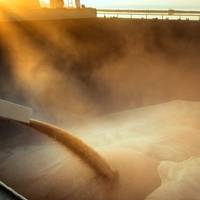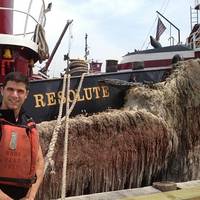OP/ED: Farm Facts

USDA Study Underscores Value of Inland Waterways to U.S. Agriculture.On August 28, U.S. Secretary of Agriculture Sonny Perdue and Assistant Secretary of the Army (ASA) for Civil Works R.D. James toured Mel Price Locks and Dam in Alton, Illinois, and held a Town Hall Meeting to discuss the importance of the waterways, agriculture and the U.S. economy. At the event, Secretary Perdue briefed agricultural and waterways stakeholders on a newly released study – Importance of Inland Waterways to U.S. Agriculture – from the U.S.
Op/Ed: USCG Forges the Future of Navigation

Maintaining the system of buoys and beacons that guide mariners through our nation’s waterways is the United States Coast Guard’s oldest mission. Tracing its roots to the ninth law passed by Congress in 1790 that moved lighthouses under Federal control, the U.S. Lighthouse Service and its vast portfolio of buoys, beacons, buoy tenders and lightships were a founding part of the U.S. Coast Guard in 1939. Along with the mission, many of the beacons the Coast Guard maintains today date back centuries.
Shipping Sector Emissions: LNG, Methanol Lead the Pack
A recent JRC report finds that fuels like liquefied natural gas (LNG) and methanol are the most promising alternatives to drive decarbonisation of the shipping sector and ultimately contribute to the fight against climate change. Market penetration by alternative fuels has already begun with ship builders, engine manufacturers and classification societies by introducing greener ships running on cleaner fuels. Shipping is more fuel-efficient than road transport: it requires 2-3 grams of fuel per ton per km, compared to road transport by truck which is about 15 grams of fuel per ton per km. However, its greenhouse gas emissions are substantial, representing 4% of the EU’s GHG emissions in 2013, and growing fast.
Coast Guard-AWO Vessel Rider Program Kicks Off Second Year

For the second consecutive year, cadets from the U.S. Coast Guard Academy are spending time on board tugboats and towboats this summer as part of a program under the auspices of the Coast Guard-American Waterways Operators (AWO) Safety Partnership. The Coast Guard Academy Cadet Towing Vessel Rider Program was established in February 2012 to educate cadets on the tugboat, towboat and barge industry through a week or more of shoreside and onboard training. This year’s program is off to a strong start…
Waterways Council Debuts New Website
Waterways Council, Inc. (WCI) has created a unique web site –www.waterwayscouncil.org – to educate the general public about the value of a modern and well-maintained national system of ports and inland waterways. The site includes general information about WCI; a discussion of the waterways from their earliest beginning during the Lewis and Clark era to the present; a look at how “Waterways Work for America” in different industries; a U.S. map which highlights inland waterways’ priority projects and offers in-depth profiles on these projects; profiles and analysis for states with major waterways systems; information on “Restoring Trust to the Trust Fund” and “Our Lock and Dams: Aging Ungracefully”…
Brown Water Industry Currently ‘In Transition’
The profitable process of moving products through North America’s vast inland waterways systems is increasingly dependent on vessel owners and operators finding and incorporating new technological means and methods to increase efficiencies. That was a core message at a recent meeting sponsored by the Ship Operations Cooperative Program (SOCP) and held in early March at the Litton-Avondale Shipyard. According to American Waterways Operators’ Ken Wells and others who spoke at the conference, market expansion projections are flat both in terms of materials moved and the overall customer base of shippers. Thus, the onus is squarely on owners and operators to ensure that their fleets are adequately outfitted to save precious time, money and fuel.
Technology, Image Top Inland Agenda
The North American inland marine market is neither technologically archaic nor as environmentally hazardous as many individuals outside of the marine market may think. These two issues dominated a recent meeting sponsored by the Ship Operations Cooperative Program (SOCP) held in early March at the Litton-Avondale Shipyard. The profitable process of moving products through North America's vast inland waterways systems is increasingly dependent on vessel owners and operators finding and incorporating new technological means and methods to increase efficiencies. Speakers from industry leading companies such as Kirby Barge Co.; Ingram Barge Co.…





